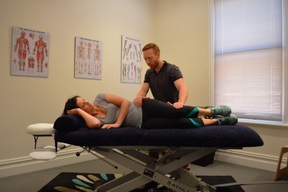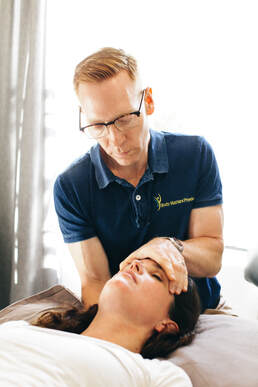Treatment
At Body Matters Physio we conduct a thorough assessment, then treat with a variety of techniques, some of which are not found in many physio clinics in Adelaide, and can be very gentle but extremely effective. Read below to learn a bit about how these techniques can help you.

Strain-Counter Strain:
If you have noticed that you can stretch over and over but get no lasting lengthening of your tissues, this treatment could be great for you. In simple terms, there can be neuromuscular reflexes that keep those tissues 'locked short' and strain-counter strain can 'unlock' these reflexes, allowing your tissues to lengthen again.
This is a gentle, yet effective technique where the practitioner will locate "tender points" in muscles, ligaments and fascia of your body. These Tender Points (not the same thing as trigger points or acupuncture points) are thought to be indicators of a local dysfunction, where local protective reflexes in the neural system inhibit 'normal' posture or movement patterns.
These dysfunctions cause your body to be moving in less than ideal patterns by tightening or guarding, and can inhibit healing, or lead to further injury and pain.
Once tender points are located, treatment involves specific positioning of the body which is gentle and immediately and significantly reduces pain in the tender point. The practitioner holds that position for 90 seconds, allowing the guarding reflex to diminish, allowing the tissue to lengthen and improve the way your body can move and heal.
Counter-strain is a great technique as it is gentle and painless, but because we are treating the underlying causes of tension, the effect on movement and posture is significant. The other amazing thing with counter strain is that the tender points limiting your movement can be in places you wouldn't necessarily think to look, (but a counter strain practitioner knows where to look!)
If you have noticed that you can stretch over and over but get no lasting lengthening of your tissues, this treatment could be great for you. In simple terms, there can be neuromuscular reflexes that keep those tissues 'locked short' and strain-counter strain can 'unlock' these reflexes, allowing your tissues to lengthen again.
This is a gentle, yet effective technique where the practitioner will locate "tender points" in muscles, ligaments and fascia of your body. These Tender Points (not the same thing as trigger points or acupuncture points) are thought to be indicators of a local dysfunction, where local protective reflexes in the neural system inhibit 'normal' posture or movement patterns.
These dysfunctions cause your body to be moving in less than ideal patterns by tightening or guarding, and can inhibit healing, or lead to further injury and pain.
Once tender points are located, treatment involves specific positioning of the body which is gentle and immediately and significantly reduces pain in the tender point. The practitioner holds that position for 90 seconds, allowing the guarding reflex to diminish, allowing the tissue to lengthen and improve the way your body can move and heal.
Counter-strain is a great technique as it is gentle and painless, but because we are treating the underlying causes of tension, the effect on movement and posture is significant. The other amazing thing with counter strain is that the tender points limiting your movement can be in places you wouldn't necessarily think to look, (but a counter strain practitioner knows where to look!)

Muscle Energy Techniques:
A manual technique that works by correcting muscle/fascial tone issues surrounding a joint.
Trauma can cause a joint to remain tight or restricted due to muscle spasm creating an imbalance around the joint. The muscle imbalance causes uneven force on the joint as it moves, so it's movement is less than ideal and restricted.
The technique involves taking a tight joint to near-end resistance, where the spasming/shortened muscle group is getting tight, then getting the client to gently contract the spasming muscle group, so as it relaxes we can move the joint closer to it 's ideal range of movement, and the spasming muscles can relax again.
A manual technique that works by correcting muscle/fascial tone issues surrounding a joint.
Trauma can cause a joint to remain tight or restricted due to muscle spasm creating an imbalance around the joint. The muscle imbalance causes uneven force on the joint as it moves, so it's movement is less than ideal and restricted.
The technique involves taking a tight joint to near-end resistance, where the spasming/shortened muscle group is getting tight, then getting the client to gently contract the spasming muscle group, so as it relaxes we can move the joint closer to it 's ideal range of movement, and the spasming muscles can relax again.

Exercise Prescription:
I can advise of how to work your body so that you recover well and reduce chance of re-injury. This may be aimed at the local structures that need some exercise to heal fully, or areas that have developed weakness that can contribute to your issues.
Exercises need to be realistic for your fitness level and goals and suitable to your body's issues.
Cranio Sacral Therapy:
CranioSacral Therapy is a very gentle, hands-on technique.
Anatomically our brain and spinal cord are covered with layers (membranes) of tissue that have a fluid (cerebrospinal fluid) within them which serves to maintain a healthy central nervous system (among other things). This fluid rhythmically flows around, and is added and taken from the system in our skull. As the fluid flows around, our skull bones, spinal bones, sacrum (tailbone) move to accommodate this fluid flow. Craniosacral therapy works on restoring this bone and fluid movement.
The craniosacral system can be considered 'deeper' than the musculoskeletal system- perhaps likened to the foundation of a house. If this system is functioning poorly, there are follow on consequences in the body's ability to operate.
The practitioner will monitor the strength, symmetry, quality of the above mentioned movement and with extremely gentle pressure help improve this rhythm, you will be surprised with the gentleness of the technique. People at first often query how such light touch could have an effect and the answer is that the cranio sacral movement is very subtle and we are treating very gentle structures (membranes), strong forces are not required or effective in treating this system, yet the effective treatment of the system can have very powerful effects on the body. Your nervous system controls every aspect of your body.
Some practitioner treat wholly with craniosacral therapy, I do not, but incorporate CST into treatment with other techniques and find it very helpful particularly with headaches, chronic pain and other aspects of 'poor health'.
Soft Tissue Release:
Massage, stretching, trigger- point ischemic pressure, and transverse frictions can all have local healing effects and greater movement improvements.
See the Dry Needling, Muscle Energy Techniques and Strain-Counter Strain sections to see how these techniques also have fantastic soft tissue release effects.
Movement re-education:
If you have injured tissue, pain, fear of movement, perform repetitive tasks, or many other factors, your body may adapt how it moves to avoid pain in our daily activities or in sport.
As the body heals, these adaptations can actually inhibit complete healing, or you can heal really well locally but maintain poor movement patterns which actually become a reason for ongoing pain and movement restriction.
Education and some hands-on guiding can re-pattern movements and allow healing, improved function, pain reduction and reduced chance of injury recurrence.
Joint mobilisations and manipulations:
Mobilisation of a joint is a technique where the practitioner will move the clients joint/joints into some resistance, then move the joint into/out of resistance with varying levels of force as required.
This loosens the local muscles, connective tissue, ligaments around the joint and increases the range of available joint movement.
This technique can also have positive effects on the way our brain is interpreting information from the body area, and allow less sensitisation as our nerves and brain start to 'turn-down' or normalise the messages they are interpreting as pain.
Location38 Chief Street
Brompton SA 5007 |
|

